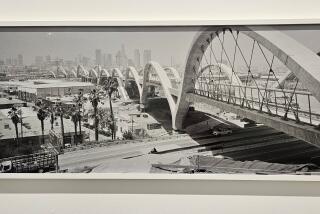Art Review
- Share via
New York, New York: Arthur Leipzig and Berenice Abbott’s photographs of New York in the 1930s, ‘40s and ‘50s exert an irresistible, nostalgic tug, even if you have only a tenuous relationship to the city and couldn’t possibly have been there during those years. Thanks to the vitality and immediacy of Leipzig’s and Abbott’s visions, the strong sense of both place and time that they conjure, you are there, in the moment of each photograph, wherever and whenever you happen to see it.
The pairing of these two photographers at Peter Fetterman Gallery is apt, not only because Leipzig (born in 1918) and Abbott (1898-1991) are of proximate vintage, but because they complement each other terrifically. Abbott sets the stage and Leipzig delivers the characters and plot. They both revel in the textures and rhythms of life in New York, Abbott making a syncopated mosaic out of the magazine covers at a newsstand, Leipzig capturing three young men diving into the East River looking as if they were a single figure at three successive stages of a dive.
Abbott photographed “Changing New York” for the WPA between 1935 and 1939, and this selection from the series testifies to its documentary purpose. The images are consistently clean, crisp and loaded with information. They reflect a democratic approach to the vast subject, rendering a small Greenwich Village cheese shop and the cavernous Penn Station equally significant to the rich fabric of the city. Abbott’s photographs document technological and architectural change in New York’s outward shape, but they also embody modernist leanings of their own, in the dynamic bird’s-eye and worm’s-eye views that were so popular with European interwar photographers, and in the nostalgia-tinged storefront images that borrow so much from her friend Atget’s visual catalog of Parisian shop fronts.
Leipzig was initiated into the field through the humanistic instruction of the Photo League, and his pictures are far less about material conditions than about the architecture of human relations. Like Helen Levitt, he focuses frequently on urban children at play, turning a stretch of pavement into a chalk-lined carnival or a mailbox into a comfy perch. Their resourcefulness reads as a profound lesson in the value of spontaneity, energy, openness. Leipzig’s work is street photography of the highest order, a torrent caught midstream, an urban ballet played out one frame at a time.
*
* Peter Fetterman Gallery, Bergamot Station, 2525 Michigan Ave., A-7, Santa Monica, (310) 453-6463, through Aug. 31. Closed Mondays.
More to Read
The biggest entertainment stories
Get our big stories about Hollywood, film, television, music, arts, culture and more right in your inbox as soon as they publish.
You may occasionally receive promotional content from the Los Angeles Times.










